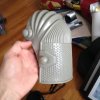TKCC71
Well-Known Member
Been playing with the electronics and was wondering if any the technical adruino experts can help me out with the sketch.
I have a Adruino Pro Mini that is running 2 neopixel rings and 10 additional RGB LEDs from pin 6. The first 26 LEDs are dedicated for the Arch reactor and then followed by 10 RGB Leds that are spread out through out the chest. back and arms. I would like to get the first 26 LEDs in the arch reactor to power up (Typical reactor style) and then followed by the other 10 powering up gradually (simultaneously) after that.
Any assistance would be greatly appreciated.
I have a Adruino Pro Mini that is running 2 neopixel rings and 10 additional RGB LEDs from pin 6. The first 26 LEDs are dedicated for the Arch reactor and then followed by 10 RGB Leds that are spread out through out the chest. back and arms. I would like to get the first 26 LEDs in the arch reactor to power up (Typical reactor style) and then followed by the other 10 powering up gradually (simultaneously) after that.
Any assistance would be greatly appreciated.





